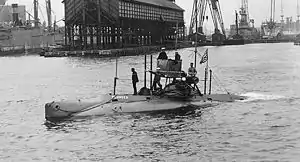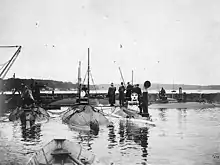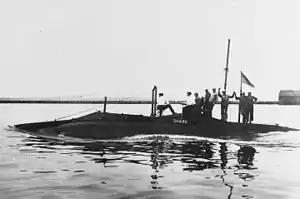Plunger-class submarine
The Plunger class was an early class of United States Navy submarines, used primarily as training and experimental vessels for the newly formed "silent service" to familiarize naval personnel with the performance and operations of such craft. They were known as the "A class" after being renamed to A-type designations (A-1 through A-7) on 17 November 1911. All except Plunger ended up being stationed in the Philippines, an American possession, prior to the outbreak of World War I. They were shipped there on colliers (coal-carrying ships). In some instances, this class of submarines is referred to as the Adder class, as USS Adder was the first boat of the class to be completed.[1][2]
 USS Plunger (SS-2) | |
| Class overview | |
|---|---|
| Builders: |
|
| Operators: |
|
| Preceded by: | USS Holland |
| Succeeded by: | B class |
| Built: | 1900-1903 |
| In commission: | 1903-1921 |
| Completed: | 7 |
| Retired: | 7 |
| Preserved: | 0 |
| General characteristics | |
| Type: | Midget submarine |
| Displacement: | 107 tons |
| Length: | 63 ft 10 in (19.46 m) |
| Beam: | 11 ft 11 in (3.63 m) |
| Draft: | 10 ft 7 in (3.23 m) |
| Propulsion: |
|
| Speed: |
|
| Test depth: | 150 ft (46 m) |
| Complement: | 7 |
| Armament: | One 18-inch (450 mm) torpedo tube (3 long or 5 short torpedoes) |


Design and construction
The Plunger-class submarines were built at the beginning of the twentieth century largely as experimental vessels. The prototype, named Fulton, was later sold to Russia, and renamed Som. The Plunger class was built at two different locations on both coasts of the United States.
Service
The five East Coast boats were based at New Suffolk, New York from 1903 until 1905, allowing New Suffolk to claim to be the first submarine base in the United States.[3] The squadron moved from New Suffolk to Newport, Rhode Island in 1905 where they were used to test torpedoes and develop submarine tactics.
In 1908 the A-2, A-4, A-6 and A-7 were moved on ships to Subic Bay in the Philippine Islands, where they served through the First World War. They were joined in 1915 by A-3 and A-5.
The class was given alphanumeric hull classification symbols (SS-2, SS-3, etc.) on 17 July 1920, after all but Grampus (SS-4) and Pike (SS-6) had been decommissioned. All of the Plunger-class boats were decommissioned by 1921, and all except Plunger used as targets. They were stricken from the Naval Vessel Register on 16 January 1922 and sold for scrap.[1]
Boats in class
| Designation: | Submarine Torpedo Boat No. 2, SS-2 |  |
| Builders: | Crescent Shipyard in Elizabethport, New Jersey | |
| Laid down: | 21 May 1901 | |
| Launched: | 1 February 1902 (List) | |
| Operator: | ||
| Commissioned: | 19 September 1903 (List) | |
| Decommissioned: | 24 February 1913 (List) | |
| Fate: | Sold for scrap 26 January 1922 | |
| Operations: | Torpedo testing, training, Theodore Roosevelt tour. Second US Navy submarine to be decommissioned. |
| Designation: | Submarine Torpedo Boat No. 3, SS-3 | .jpg.webp) |
| Builders: | Crescent Shipyard in Elizabethport, New Jersey | |
| Laid down: | 3 October 1900 | |
| Launched: | 22 July 1901 (List) | |
| Operator: | ||
| Commissioned: | 12 January 1903 (List) | |
| Decommissioned: | 12 December 1919 (List) | |
| Fate: | Sunk as a target ship | |
| Operations: | Torpedo testing, training, peace time patrol. Moved to Philippines in 1909. |
| Designation: | Submarine Torpedo Boat No. 4, SS-4 | .jpg.webp) |
| Builders: | Union Iron Works in San Francisco, California | |
| Laid down: | 10 December 1900 | |
| Launched: | 31 July 1902 (List) | |
| Operator: | ||
| Commissioned: | 28 May 1903 (List) | |
| Decommissioned: | 25 July 1921 (List) | |
| Fate: | Struck 16 January 1922 and sunk as a target ship | |
| Operations: | San Francisco earthquake of 1906 relief efforts. Moved to Philippines in 1915. |
| Designation: | Submarine Torpedo Boat No. 5, SS-5 | .jpg.webp) |
| Builders: | Crescent Shipyard in Elizabethport, New Jersey | |
| Laid down: | 8 November 1900 | |
| Launched: | 20 August 1901 (List) | |
| Operator: | ||
| Commissioned: | 17 January 1903 (List) | |
| Decommissioned: | 12 December 1919 (List) | |
| Fate: | Target ship | |
| Operations: | Training, trials, peacetime patrol. Moved to Philippines in 1909. |
| Designation: | Submarine Torpedo Boat No. 6, SS-6 | .jpg.webp) |
| Builders: | Union Iron Works in San Francisco, California | |
| Laid down: | 10 December 1900 | |
| Launched: | 14 January 1903 (List) | |
| Operator: | ||
| Commissioned: | 28 May 1903 (List) | |
| Decommissioned: | 25 July 1921 (List) | |
| Fate: | Sold for scrap 26 January 1922 | |
| Operations: | San Francisco earthquake of 1906 recovery efforts, training & trials, harbor patrol. Moved to Philippines in 1915. |
| Designation: | Submarine Torpedo Boat No. 7, SS-7 | _and_Shark_(SS-8)%253BH98835k.jpg.webp) |
| Builders: | Crescent Shipyard in Elizabethport, New Jersey | |
| Laid down: | 13 December 1900 | |
| Launched: | 23 September 1901 (List) | |
| Operator: | ||
| Commissioned: | 19 September 1903 (List) | |
| Decommissioned: | 12 December 1919 (List) | |
| Fate: | Target ship | |
| Operations: | Whiting experiment, other trials, harbor patrols. Moved to Philippines in 1908. |
| Designation: | Submarine Torpedo Boat No. 8, SS-8 |  |
| Builders: | Crescent Shipyard in Elizabethport, New Jersey | |
| Laid down: | 11 January 1901 | |
| Launched: | 19 October 1901 (List) | |
| Operator: | ||
| Commissioned: | 19 September 1903 (List) | |
| Decommissioned: | 12 December 1919 (List) | |
| Fate: | Target ship | |
| Operations: | Torpedo and other trials, Manila Bay patrols. Moved to Philippines in 1908. |
See also
- Holland-class submarine (British Royal Navy version)
References
- Gardiner, p. 127
- Friedman, pp. 27-31
- "History of Cutchogue-New Suffolk". cutchoguenewsuffolk.org. Archived from the original on 29 April 2006. Retrieved 2007-11-04.
Bibliography
- Bauer, K. Jack; Roberts, Stephen S. (1991). Register of Ships of the U.S. Navy, 1775-1990: Major Combatants. Westport, Connecticut: Greenwood Press. ISBN 0-313-26202-0.
- Friedman, Norman (1995). U.S. Submarines Through 1945: An Illustrated Design History. Annapolis, Maryland: Naval Institute Press. pp. 285–304. ISBN 1-55750-263-3.
- Gardiner, Robert; Gray, Randal (1985). Conway's All the World's Fighting Ships, 1906-1921. London: Conway Maritime Press. ISBN 0-85177-245-5.
- Silverstone, Paul H. (1970). U.S. Warships of World War I. London: Ian Allan. ISBN 0-71100-095-6.
- Wright, C. C. (2003). "Question 40/02: Submarines Expended as Targets 1922". Warship International. XL (4): 286–298. ISSN 0043-0374.
- This article incorporates text from the public domain Dictionary of American Naval Fighting Ships.
External links
External links
| Wikimedia Commons has media related to Plunger class submarines. |